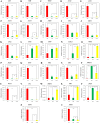Transcriptome Analysis Provides a Preliminary Regulation Route of the Ethylene Signal Transduction Component, SlEIN2, during Tomato Ripening
- PMID: 27973616
- PMCID: PMC5156437
- DOI: 10.1371/journal.pone.0168287
Transcriptome Analysis Provides a Preliminary Regulation Route of the Ethylene Signal Transduction Component, SlEIN2, during Tomato Ripening
Abstract
Ethylene is crucial in climacteric fruit ripening. The ethylene signal pathway regulates several physiological alterations such as softening, carotenoid accumulation and sugar level reduction, and production of volatile compounds. All these physiological processes are controlled by numerous genes and their expression simultaneously changes at the onset of ripening. Ethylene insensitive 2 (EIN2) is a key component for ethylene signal transduction, and its mutation causes ethylene insensitivity. In tomato, silencing SlEIN2 resulted in a non-ripening phenotype and low ethylene production. RNA sequencing of SlEIN2-silenced and wild type tomato, and differential gene expression analyses, indicated that silencing SlEIN2 caused changes in more than 4,000 genes, including those related to photosynthesis, defense, and secondary metabolism. The relative expression level of 28 genes covering ripening-associated transcription factors, ethylene biosynthesis, ethylene signal pathway, chlorophyll binding proteins, lycopene and aroma biosynthesis, and defense pathway, showed that SlEIN2 influences ripening inhibitor (RIN) in a feedback loop, thus controlling the expression of several other genes. SlEIN2 regulates many aspects of fruit ripening, and is a key factor in the ethylene signal transduction pathway. Silencing SlEIN2 ultimately results in lycopene biosynthesis inhibition, which is the reason why tomato does not turn red, and this gene also affects the expression of several defense-associated genes. Although SlEIN2-silenced and green wild type fruits are similar in appearance, their metabolism is significantly different at the molecular level.
Conflict of interest statement
The authors have declared that no competing interests exist.
Figures






References
MeSH terms
Substances
LinkOut - more resources
Full Text Sources
Other Literature Sources

